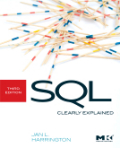
Although the core of the SQL language remains relatively unchanged, the most recent release of the SQL standard (SQL:2008) includes two sets of extensions:1) support for object-relational databases and 2) support for XML. The secondedition of this book included some material about the object-relational extensions. However, that set of commands has been greatly extended and the new edition takes that into account. The XML extensions are entirely new to the thirdedition. A chapter on basic relational concepts will be also added to broadenthe audience and make the book more complete in its own right. All of the chapters will be revised to be sure they are up to date. Chapter 10 ("Views, Temporary Tables, and Indexes") from the second edition will be expanded to include common table expression (CTEs). The material in the existing Chapter 14 ("Unimplemented SQL-92 Features 251") will be disbursed through the chapters wherethe particular type of operation is discussed. While the content throughout will be updated where necessary, the existing organizational structure through chapter 14 will remain largely intact because this coverage represents the stable portion of the SQL language.There will be two NEW chapters at the beginning of the book. Chapter 1 ("The Relational Data Model") covers the relational data model conceptual material; Chapter 2 ("Manipulating Relations with Relational Algebra") covers the relational algebra material that will be pulled from the retrieval chapters. Part 5 ("Non-relational SQL Extensions") will now include the non-relational SQL extensions in three chapters. Chapter 17 (NEW) willcover XML. Chapter 18 will contain the object-relational conceptual material from the original chapter 15 and chapter 19 (NEW) will cover SQL object-relational support. (Some of chapter 19 will come from the second edition, however, a great deal of object-relational support has been added to the current standard and therefore needs to be added.) The other NEW chapter is Chapter 14, which covers triggers and stored procedures. This material was missing from previous editions. Many readers should find it a useful addition. Demonstrates how to formulate SQL queries and how queries are processed to maximize performance of the database management system Explains use of SQL to enter, modify or delete data to maintain database structural elementsCovers in great detail new SQLapplication for XML to meet the growing XML usage in development of online content
- ISBN: 978-0-12-375697-8
- Editorial: Morgan Kaufmann
- Encuadernacion: Rústica
- Páginas: 448
- Fecha Publicación: 27/07/2010
- Nº Volúmenes: 1
- Idioma: Inglés
- Inicio /
- INFORMÁTICA /
- SQL
